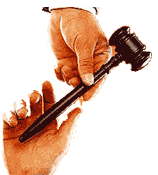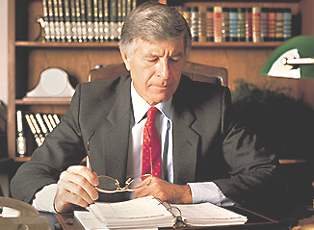Staging also involves the reenactment of events. Sometimes this is deemed acceptable, sometimes not.
For
example, if you are covering "the handing over of the gavel"
to a newly-elected officer during a  meeting, you will frequently find that the people involved often expect--maybe
even prefer--to do the whole thing over again for the media afterwards.
This allows camera people to light the scene as they want, make sure
no people are blocking camera angles, and arrange people so they can
all be clearly seen. It is doubtful that the public expects authenticity
in this type of situation.
meeting, you will frequently find that the people involved often expect--maybe
even prefer--to do the whole thing over again for the media afterwards.
This allows camera people to light the scene as they want, make sure
no people are blocking camera angles, and arrange people so they can
all be clearly seen. It is doubtful that the public expects authenticity
in this type of situation.
But, there are other times when the public assumes they are seeing "the moment." If you reenact a critical moment in sports history when someone breaks the world hi-jump record, and you don't bother to inform your audience that what they are seeing is actually a warm-up or a reenactment, it's an entirely different matter. Question: is it unethical to simply enhance a news photo by removing distractions on a desk, moving a coat rack out from behind someone's head, or setting up your own special lighting? Although "purists" might argue that you are "tampering with the truth" if you change anything in a scene, most newspaper photographers and videographers (TV camerapersons) routinely do this when they see a need. The dividing line is whether they are enhancing a scene for the sake of clarity and technical quality, or if they are distorting the truth.
Using Comparable Footage or Pictures
A related issue is the use of comparable footage, videotape that appears to be the event being reported, but is from an earlier time. You might be tempted to cut in some unused scenes from yesterday's forest fire to illustrate today's story on the same fire, or use a news photo of a forest fire from last year. Some people might say, "A fire's a fire, what's the difference?" Well, there is a difference, and regulatory agencies have taken a dim view of this kind of thing--unless the fact is made quite clear to the viewing audience. Simply keying the phrase "file footage," over TV news footage, or in the case of a newspaper photo, a clarifying caption such as "John Jones during Senate hearings in 1995," should head off any misunderstanding.
Copyrighted Materials
Music, photo illustrations, drawings and published text are copyrighted and cannot be broadcast or reproduced for distribution without clearance or permission from the copyright holder. Under 1998 copyright revisions, copyright now extends for the life of an artist plus 70 years, and copyrights owned by corporations run for 95 years. However, in 2003, these time periods are under review.  Using something that's copyrighted without permission can result in a $25,000 fine and one year in prison. (And that's only for the first offense; things get worse after that.) Using something that's copyrighted without permission can result in a $25,000 fine and one year in prison. (And that's only for the first offense; things get worse after that.)
For example, these cybertext materials are protected by
international copyright law and can only be used directly from the
Internet from either CyberCollege.com or InternetCampus.com.
Although it's clearly stated that these materials can't be downloaded and used on institutional computers or servers, distributed in printed form, or used for commercial purposes without violating copyright law, one non-democratic country reproduced the materials for its own purposes and, in the process, all references to freedom of the press mysteriously disappeared. (One disgruntled person in that country brought this to our attention.) Sometimes, especially in the case of noncommercial television use, permission to use copyrighted materials will be granted without charge or for on-screen credit. More typically, a fee must be paid to the copyright holder. But, to protect yourself and your company or institution, make sure you get the permission in writing. In the case of videos, you can feel reasonably safe using copyrighted material that will be viewed only by family members or a small group of people where no admission is charged. In the case of printed materials, copies can generally be made for personal use. But once these copies are distributed to a group, you transgress copyright law unless the material comes under the "fair use act" as explained below. Text, photos, film, or video produced by the U.S. federal government do not fall under copyright restrictions unless they were done by an outside agency that used copyrighted material. It's best to check.
The Fair Use Act
The fair use act allows copyrighted material to be used in limited ways for criticism, teaching, scholarship, news, or research without the permission of the copyright holder. Frankly, the fair use act is not well defined; and, unfortunately, we'll only get a clearer picture of what constitutes fair use after a number of court cases have addressed the issue. It is assumed--we would hope, accurately--that under this act small portions of copyrighted work can be used for a limited time for criticism, teaching, scholarship, news, or research, as long as this use doesn't appreciably affect the income that could be derived from the work by the copyright holder. The fair use act excludes use of copyrighted materials for other than immediate criticism, teaching, scholarship, news, or research; and, of course, it excludes the reproduction of materials in their entirety.
Works in the Public Domain
A work is in the public domain when its copyright has expired. Although many old music selections are in the public domain, you need to watch out for recent arrangements of older works that have come under new copyright restrictions.
Securing Rights to Music
Obtaining clearance to use a copyrighted music selection consists of three steps. - you need to get a synchronization license from the music copyright owner
- you must get dubbing rights from the record company that produced the record
- you must get the artist's permission
 This
is a cumbersome process, and we won't go into all the details here, but
there are agencies that specialize in securing music clearance. This
is a cumbersome process, and we won't go into all the details here, but
there are agencies that specialize in securing music clearance.
There are also organizations such as ASCAP (American Society of Composers, Authors and Publishers) and BMI (Broadcast Music Incorporated) that specialize in licenses for music used in productions and on-air broadcasts. But even if your broadcast station or production agency subscribes to one of these services, it's important to note that the standard performing rights license that you typically pay for does not cover the use of music in commercials, public service announcements and productions. You need to check your license carefully to see what it does and does not cover.
Music and Sound Effect Libraries
Since music clearance is complex and cumbersome, many people opt for audio libraries that can be purchased on CD's that consist of a wide variety of musical selections and sound effects. Once the library is purchased, you can use the material over an extended length of time for most production purposes. Material in these libraries has been written or selected with the needs of the video and film producer in mind. With titles like "Manhattan Rush Hour," and "Serenity," you immediately know the nature of the musical selections. One of the largest collections of sound effects, featuring some 2,500 effects on 60 CDs, is the BBC Sound Effects Library. Under "Cars," for example, you will find sound effects such as windshield wipers, horns, various engines, a car stalling, doors slamming, windows opening, seat belts snapping, a car passing, and a car skidding. Under "Babies" you will find crying, hiccups, gurgling, laughing, bathing, babbling, coughing, first words, singing, and tantrums.
Using Original Music
To get around many of the problems in the use of music, many producers prefer to use original music. There are three main  advantages. advantages. - it solves clearance problems
- the music can be tailored to moods, pace and time requirements
- it eliminates the "emotional baggage" (mental associations) that can accompany well known musical selections
If the music is relatively simple (possibly a guitar, flute or organ), or it is electronically synthesized (which most music is today), original music can be done rather inexpensively. In the hands of an expert, a music synthesizer (see photo above) can create the sound of anything from a single instrument to a full orchestra.
Talent Releases
Using someone's "likeness" (a photo or a video of them) without their permission can get you into legal trouble--especially if you use that "likeness" for commercial purposes. By having the person sign a talent release or a model release you can be granted the permission you need. This protects a photographer in case someone later decides they don't want the footage broadcast or printed, or they demand extra compensation. Here is a  sample talent release for television. sample talent release for television.
Location Release
It may come as a surprise that you may need a release to film on some property. For example, you could not use a well-known amusement part as a setting for your commercial video without the permission of the property owner. Many commercial establishments, such as supermarkets, malls, casinos, restaurants, etc., routinely forbid photography (especially if you appear to be making pictures for professional purposes).
Bear in mind that the "once over lightly" treatment of complex legal issues in these modules is only designed to alert you to possible danger areas. Law libraries have thousands of books on these areas--and there is still great uncertainty about what's legal and what isn't.
About the only thing we know for sure is that lawsuits are
very expensive for all parties involved, and the best defense is no offense.
Next, we'll pull all of the broadcasting modules together into a succinct timeline. | 
 meeting, you will frequently find that the people involved often expect--maybe
even prefer--to do the whole thing over again for the media afterwards.
This allows camera people to light the scene as they want, make sure
no people are blocking camera angles, and arrange people so they can
all be clearly seen. It is doubtful that the public expects authenticity
in this type of situation.
meeting, you will frequently find that the people involved often expect--maybe
even prefer--to do the whole thing over again for the media afterwards.
This allows camera people to light the scene as they want, make sure
no people are blocking camera angles, and arrange people so they can
all be clearly seen. It is doubtful that the public expects authenticity
in this type of situation.
 This
is a cumbersome process, and we won't go into all the details here, but
there are agencies that specialize in securing music clearance.
This
is a cumbersome process, and we won't go into all the details here, but
there are agencies that specialize in securing music clearance. advantages.
advantages.